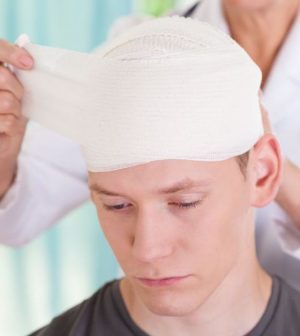- CDC Cuts Key Smoking Programs Despite Success in Curbing Smoking Rates
- RFK Jr. Touts Vaccine While At Funeral of Texas Girl Who Died of Measles
- Biden Plan To Expand Obesity Drug Coverage Is Rejected
- Most Eligible Smokers Not Getting Lung Cancer Screening
- Heart-Related Deaths More Likely During Day/Night Heatwaves
- Wildfire Smoke Increases Risk Of Mental Health Problems
- Some Folks Hit With Fees for Using Health Care Message Portals
- Diarrhea-Causing Bacteria Spreading Undetected Through Hospitals
- Ozone Pollution Increases Risk Of Childhood Asthma
- Knee Replacement Recovery Time: What You Need To Know
1 in 4 U.S. Teens Has Had a Concussion: Study

Nearly one in four American teens has suffered at least one concussion, according to new research.
And though more teens are self-reporting sports-related concussions, visits to the emergency room for these traumatic head injuries fell between 2012 and 2018.
“One reason that could explain why adolescents who participate in sports saw an increase in self-reported concussion could be due to greater awareness of these types of injuries,” said study author Philip Veliz. He is an assistant research professor at the University of Michigan School of Nursing, in Ann Arbor.
For the study, his team looked at nearly 53,000 students in grades 8, 10 and 12, and found that self-reported concussions rose between 2016 and 2020. Specifically, in 2016, 19.5% of teens said they’d experienced at least one concussion; by 2020 that number had risen to 24.6%, the findings showed.
“Self-reported concussions could be increasing given that both children and parents have greater knowledge with respect to these injuries,” Veliz said. “We have seen a greater effort in the U.S. to educate the population regarding the risks associated with head injuries, and may have greater knowledge with respect to symptoms associated with these types of injuries.”
Self-reported concussion, however, did not increase across all groups. There was no increase, for instance, among teens who did not participate in sports.
Veliz said these new findings do not contradict studies based on emergency department data that have reported a decline in these types of injuries.
“More adolescents may be seeking care for these injuries, including care from health professionals outside the emergency department who have appropriate diagnosis and management skills,” Veliz explained.
The U.S. Centers for Disease Control and Prevention describes a concussion as a type of brain injury that happens when a blow to the head or body causes the head and brain to move rapidly back and forth, causing changes in the brain.
While they may not be life-threatening, concussions can still be serious. Symptoms may include a headache, neck pain, nausea, ringing in the ears, dizziness or tiredness. More serious symptoms include convulsions or seizures, an inability to wake up and loss of consciousness, according to the U.S. National Library of Medicine.
Major sports organizations, including those governing youth sports in the United States, have taken steps to reduce concussion risk in recent years.
Veliz said it is important, with the increase in reports of teen concussions, for the public to be aware of these injuries and the best ways to prevent and treat them.
“Concussions appear to be a common injury among adolescents. Roughly one in four have indicated this type of injury,” Veliz said. “Continued efforts to educate the population on both the risk and management of these injuries should still remain a priority as it relates to adolescent health.”
Dr. Teresa Murray Amato, head of emergency medicine at Long Island Jewish Forest Hills in New York City, reviewed the findings. She said more awareness of concussion among teen athletes is important for keeping healthy.
“It is unclear if the actual number of concussions are increasing or if increased education and awareness of what concussion symptoms are leads to increased self-reporting,” Amato said.
She noted that many school districts are educating students and parents about the danger of not reporting symptoms.
“As we learn more about long-term side effects of childhood concussions, it is important to track both increases in the number of concussions as well as self-reporting,” Amato said.
Reporting concussions may lead to development of ways to keep athletes in tip-top shape, she added.
“Increased self-reporting may also help public health officials and school officials create safeguards to keep student athletes as healthy as possible while partaking in organized sports that may be at a high risk of concussions,” Amato said.
The findings were published May 4 in the Journal of the American Medical Association.
The researchers stressed that continued efforts to monitor and prevent concussion are needed. One limitation of the study was use of self-reported measures of concussion, they noted.
More information
To learn more about concussion, visit the U.S. Centers for Disease Control and Prevention.
SOURCES: Philip Veliz, PhD, assistant research professor, University of Michigan School of Nursing, Ann Arbor; Teresa Murray Amato, MD, chairwoman, emergency medicine, Long Island Jewish Forest Hills, New York City; Journal of the American Medical Association, May 4, 2021
Source: HealthDay
Copyright © 2025 HealthDay. All rights reserved.










